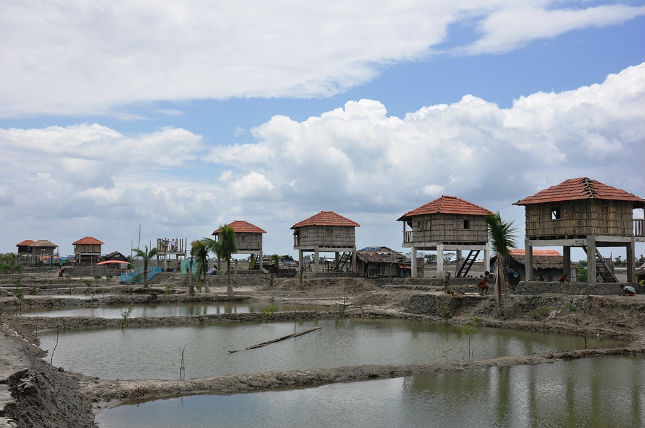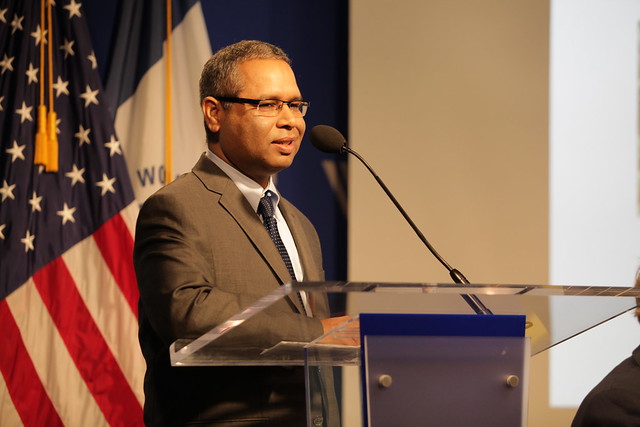-
“Let’s Start From Here”: Local Solutions for Loss and Damage and Livelihood Resilience
December 6, 2017 By Saiyara Khan
Without warning, water rushed into a woman’s home on a raised platform above the floodplain of Bangladesh’s Teesta River. She was just a hand’s distance from her infant son, but she couldn’t stop him from falling into the floodwaters. “She can’t recover back from the trauma,” said the University of Dundee’s Nandan Mukerjee of the mother who lost her child to the currents of climate change.
A member of the Resilience Academy, Mukerjee was joined by his colleagues and fellow experts at the Wilson Center’s recent Resilience Week event, to discuss the dimensions of loss and damage and ways to secure livelihoods in the face of climate change.
What Money Can’t Bring Back: Dimensions of Loss and Damage
“A loss is irreplaceable whereas a damage may be repairable,” Frank Thomalla, an associate at the Stockholm Environment Institute, explaining the complex and much-debated concept of loss and damage. The UNFCCC defines loss and damage as “the actual and/or potential manifestation of impacts associated with climate change in developing countries that negatively affect human and natural systems.”
“We always try to put a dollar value” on loss and damage, said Ashiqur Rahman, a postdoctoral fellow at the University of South Florida. To make these difficult valuations, said Rahman, we must ask “those who are facing the problem [and are the immediate] victims of climate change.” But the Paris climate agreement specifically excludes any liability or compensation for loss and damage.
Evaluating loss and damage through legal frameworks alone poses its own set of problems, said Ebinezer Florano of the University of the Philippines, who proposes an integrated “Loss & Damage–Climate Change Adaptation–Disaster Risk Reduction” framework that could be implemented at the local level.
One of the most challenging aspects of loss and damage is how to assess the non-economic dimensions—for example, how can we measure the loss of a community, or the damage from mental trauma? We must remember that “we cannot bring her son back,” said Rahman of the woman in Bangladesh. “It doesn’t matter how much money you are willing to pay.”
Starting at the Local Level: Leadership and Learning
“Leadership comes from all angles,” said Erin Roberts, a consultant to the Africa Adaptation Initiative and the African Group of Negotiators, who studies the role of leadership in addressing loss and damage in Bangladesh and Senegal. Leadership is not just the province of governments, said Roberts; it also comes from academia, institutions, and NGOs. Engaging civil society groups keeps the momentum going on climate change issues at the national level, her research finds.
However, “national level capacities do not necessarily translate to the local level,” said Jana Junghardt of Caritas International. “Any effort to reduce the vulnerability of people and strengthen their resilience must begin at the local level,” she said, quoting former UN Secretary-General Ban Ki-moon. In 2009, the Global Network of Civil Society Organizations for Disaster Reduction launched Views From the Frontline, the largest independent global review of local disaster risk reduction efforts. “The perspective of people that are at risk, that are at the frontline” is critical to understanding risk factors that cannot be captured by national level monitoring alone, she said.
Schools are a useful local forum, said Vishal Pathak, a consultant with All India Disaster Mitigation Institute and advocate for the Safer Schools Campaign, which empowers schools and local communities by helping them prepare for disasters. “Safe schools can be a tool for encouraging community resilience,” he said.
Mobile Apps and Floating Homes: Innovations for Livelihood Resilience
“When you have a lot of youth, you have a lot of aspirations, a lot of dreams, [and] a lot of new ways of doing things,” said Vivek Prasad, a professor at George Mason University and consultant to the World Bank. “There are a lot of challenges” to securing livelihoods in countries that are most vulnerable to climate change, he said, “but there are [also] a lot of transformations” that support sustainable development and livelihood resilience.
Technological interventions in the agricultural sector have supported the expansion of climate-smart agriculture—particularly in Africa, where farming is the primary source of income for 60 percent of the population. Digital applications such as Digital Green, a video-sharing platform for rural farmers, and Hello Tractor, a tractor-sharing mobile app, are empowering farmers and agricultural workers by putting tools to mitigate climate risks in the palm of their hands, said Prasad.
“Everything is open source and open access,” said Amy Quant, the global coordinator for the Land-Potential Knowledge System Project (LandPKS), an initiative that develops free mobile and web applications for sustainable land management at the local level. The LandInfo and LandCover apps allow users to collect and assess site-specific data on soil and vegetation. “We’re giving people who previously haven’t had access to this type of information, access to it,” she said. With it, farmers and land managers can determine what kind of crops they should plant and make more resilient land use decisions.
Some communities facing the climate challenge may no longer have land to manage. In flood-prone regions in Bangladesh, Mukerjee is working to build floating homes for people at risk of displacement. The prototype will be revealed this December for a durable, self-sufficient, and low-energy home, resilient to rising sea levels. “This is not the solution,” said Mukerjee, but “this is one of the solutions.”
Over the last five years, the Resilience Academy has brought together researchers, practitioners, and innovators like these to delve deeply into the difficult challenges of loss and damage and securing livelihood resilience. “Some failures will happen, but this is how progress is made,” said Jakob Rhyner of the Institute for Environment and Human Security at the United Nations University. “So let’s start from here.”
Sources: Brookings, Child’s Right to Safer Schools Campaign, Digital Green, “Floating Houses: A design for flood resilience innovations in Bangladesh” by Shimantika Bhattacharjee and Nandan Mukherjee, Global Network of Civil Society Organisations for Disaster Reduction, Hello Tractor, LandPKS, Munich Re Foundation, United Nations Framework Convention on Climate Change
Photo Credit: “Disaster resilient village” in Bangladesh, March 2012, courtesy of Nasif Ahmed/UNDP Bangladesh.
 A Publication of the Stimson Center.
A Publication of the Stimson Center.




